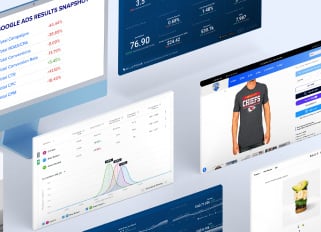
Ultimate Content Marketing Strategy for E-commerce
In the rapidly evolving world of content marketing for ecommerce businesses, standing out from the crowd is more critical than ever. One of the most effective ways to capture attention and convert leads into loyal customers is through a fine-tuned content marketing strategy.
This blog post will guide you through the essential components of developing an ultimate content marketing and content strategy for ecommerce, specifically for ecommerce.
Understanding Your Audience
Before creating content marketing campaigns, it is crucial to know who you are trying to reach. Researching and understanding your target audience's demographics, interests, and pain points will help you tailor your content to their specific needs and preferences.
Conducting Audience Research for Ecommerce
Audience research starts with digging deep into who your existing customers are and what they need. Start by utilizing tools like Google Analytics, social media insights, and customer feedback surveys to gather data about your existing customer base. Look at demographics such as age, gender, location, and buying behavior.
Engaging with your audience through social media platforms can also provide invaluable insights. Ask questions, run polls, and encourage discussions to better understand their pain points and preferences. Remember, the more you know about your audience, the better you can tailor your content to meet their needs.
Creating Buyer Personas Specific to Ecommerce
Once you've collected data about your audience, it’s time to create detailed buyer personas. These personas should embody the characteristics, behaviors, and motivations of your ideal customers. For example, if you sell fitness gear, your buyer persona may include a young professional who values quality and sustainability in athletic wear. Another one might be a stay-at-home mom looking for affordable workout clothes that can withstand daily use.
Creating these personas helps you visualize your audience and tailor your ecommerce content creation strategy to resonate with them. Each piece of content you produce should address the specific needs and interests of one or more personas.
Developing a Content Strategy
The next step is to develop a content strategy that aligns with your audience and business goals. The key is to create content that not only engages your audience but also supports your overall ecommerce objectives, such as increasing brand awareness, driving conversions, or building customer loyalty.
Setting Goals for Your Ecommerce Content Marketing
Before diving into creating content, it's essential to establish clear goals for your ecommerce content marketing strategy. Once you have set these goals, you can create a roadmap that outlines how your content creation process will help achieve them.

Choosing the Right Content Formats for Ecommerce
Ecommerce businesses have various content formats to choose from, including blog posts, videos, infographics, social media posts, and more. To decide which formats to focus on, consider what will resonate best with your target audience and align with your business goals. For example:
- Blog Posts: These are great for SEO and thought leadership pieces.
- Videos: Ideal for showcasing products or providing tutorials.
- Social Media Posts: Perfect for engaging with customers and promoting sales or new products.
- Infographics: Useful for presenting data and statistics in a visually appealing way.
Mapping Your Content to the Buyer’s Journey
The buyer’s journey refers to the stages a customer goes through before making a purchase: awareness, consideration, purchase, and loyalty. As an ecommerce business, it’s crucial to create content that caters to each stage of this journey.
For example, a blog post about the latest fashion trends can help raise awareness about your brand, while product reviews and tutorials can assist in the consideration phase of the customer journey.
Choosing the Right Types of Content
With countless forms of content available, it can be overwhelming to decide which ones are best for your ecommerce business. The key is to focus on formats and content ideas (such as the gated content ideas here) that align with your goals and resonate with your audience. This could include product videos, how-to guides, user-generated content, or influencer collaborations.
Creating a Content Calendar
Once you've chosen your content formats and media channels, it's essential to create a content calendar that outlines when and where you will publish each piece of content. A well-planned schedule ensures consistency and helps you stay on track with your content strategy. It also allows you to plan ahead for seasonal promotions, product launches, or other relevant events in the ecommerce world.
Creating Compelling Ecommerce Content
Your content marketing efforts are only as good as the content you produce. Below are a few tips for creating compelling ecommerce content.
Crafting Captivating Headlines and Descriptions
In the digital world, where consumers have a short attention span, your content's headline and description play a crucial role in capturing their interest. Use compelling language that entices them to click through and learn more about your product or brand.
Bluetuskr Tips
When crafting headlines and descriptions for your ecommerce content, make sure to use keywords that will help improve your search engine rankings. Also, consider using numbers or statistics to grab the reader's attention.
Incorporating SEO Best Practices
Search engine optimization (SEO) is vital for ecommerce sites to rank high on search engine results pages (SERPs). Conduct keyword research specific to your products and incorporate those keywords into your content naturally so search engines can recognize you. This will help improve your visibility in organic search and drive organic traffic to your ecommerce store.
Bluetuskr Tips
Don't overstuff your content with keywords, as this can actually hurt your SEO rankings. Instead, focus on creating high-quality, relevant content that naturally incorporates your target keywords.
Using High-Quality Visuals
High-quality visuals, such as product images or videos, are crucial for your ecommerce brand. They not only help showcase your products but also make your content more visually appealing and engaging. Make sure to use professional-looking photos and videos that accurately represent your brand.
Bluetuskr Tips
Invest in high-quality equipment or hire a professional photographer/videographer to capture stunning visuals for your picture and video content.
Leveraging User-Generated Content
User-generated content (UGC) is any valuable content created and shared by your customers or followers. It can include product reviews, social media posts, unboxing videos, and more. UGC adds authenticity to your brand and can help build trust with potential customers.
Bluetuskr Tips
Encourage your customers to share their experiences with your products on social media by using branded hashtags or running a user-generated content campaign. Repost and showcase this content on your own channels to increase engagement and credibility.
Promoting Your Ecommerce Content
Leveraging Social Media Marketing
Social media is a powerful tool for ecommerce businesses to reach a vast audience, engage with customers, and promote their content. Share your content on various social media platforms, utilize hashtags, collaborate with influencers, and engage with your followers to increase visibility and drive traffic to your website.
Bluetuskr Tips
Each social media platform has its own unique audience and content style. Tailor your content to fit each platform for maximum impact.

Utilizing Email Marketing
Email marketing is another effective way to promote your ecommerce and blog content. Send out newsletters to your subscriber list, highlighting new blog posts, product updates, or promotions. Make sure to include captivating visuals and a clear call-to-action (CTA) in your emails.
Bluetuskr Tips
Segment your email lists based on customer preferences, purchase history, or other relevant factors to make the content more personalized and targeted.
Analyzing and Adapting Your Strategy
Tracking and Measuring Success
To ensure your ecommerce content marketing strategy is effective, it's crucial to track and measure its success. Use tools like Google Analytics to monitor website traffic, engagement rates, conversion rates, and other key metrics regularly. This will help you identify what is working well and make adjustments where necessary.
Bluetuskr Tips
Set specific goals and KPIs (key performance indicators) for your content marketing strategy, so you have a benchmark to measure success against.
Adapting to Changes
The ecommerce landscape is constantly evolving, so it's essential to adapt your content strategy accordingly. Keep an eye on industry trends, consumer behavior, and competitor tactics to stay ahead of the game. Don't be afraid to experiment with new formats or channels if they align with your goals and target audience.
Bluetuskr Tips
Regularly review and update your content calendar to incorporate any changes or new opportunities that arise in the ecommerce world. Stay agile and open-minded in your approach.
Staying Up-to-Date with Trends
The digital marketing landscape is constantly evolving, so it's essential to stay up-to-date with the latest trends in ecommerce content marketing. Monitor industry news, competitor strategies, and consumer behavior to adjust your strategy accordingly.
Bluetuskr Tips
Join relevant industry groups or attend conferences and webinars to stay informed on the latest trends in ecommerce content marketing. Network with other professionals in the field and share insights and best practices.
Bluetuskr: Your Ecommerce Content Partner
At Bluetuskr, we don't just create content - we create compelling and effective ecommerce content designed to increase conversions. From product descriptions and blog posts to videos and social media campaigns, our team of experts can help you craft a comprehensive ecommerce content strategy that drives results.
Contact us today to learn more about how we can elevate your ecommerce business through high-quality, targeted content.
All in All...
A solid content marketing strategy is crucial for the success of ecommerce brands. By incorporating SEO best practices, using high-quality visuals, leveraging user-generated content, and promoting your content through various channels, you can attract and engage potential customers.
It's also important to regularly track and adapt your ecommerce content marketing strategy to stay ahead of trends and changes in the digital landscape. With Bluetuskr as your partner during your content marketing journey, you can trust that your ecommerce content will be effective and drive results. Interested in ecommerce content services? Reach out to our team at Bluetuskr, an e-commerce marketing agency.
Connect With Us
Recent Post

.png)







Tell us what you think!